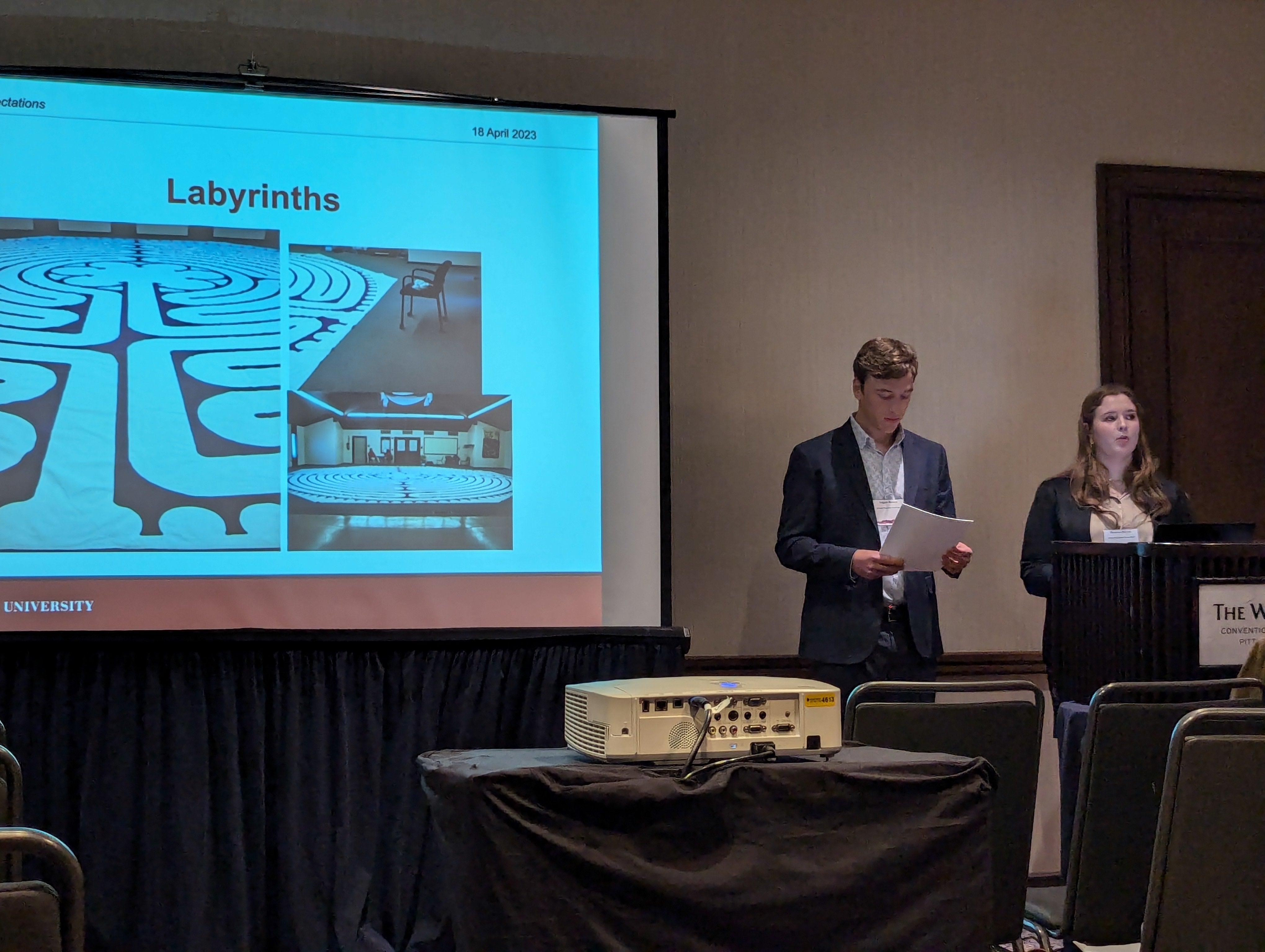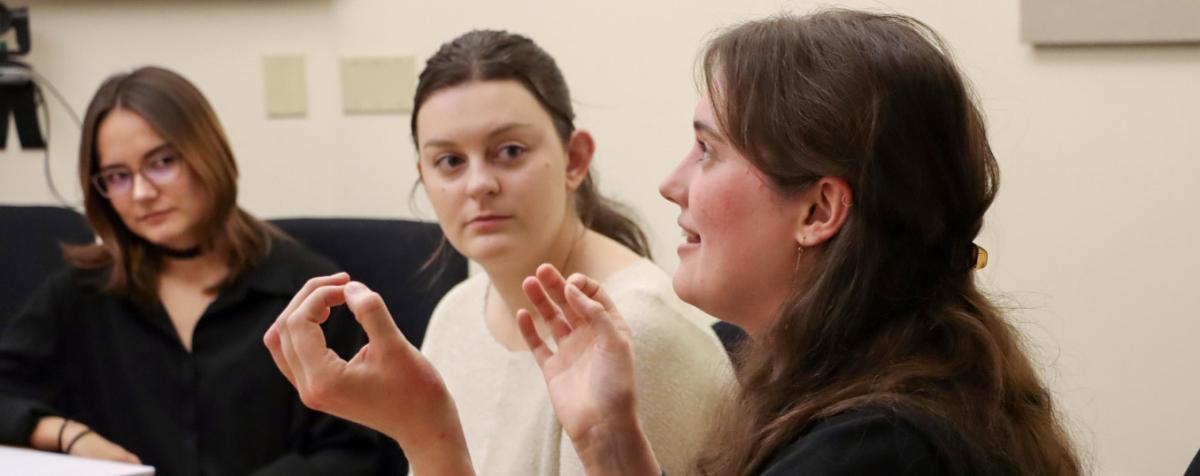Publications & Presentations
See below for select publications and presentations from MAB Lab members.
-
Featured Publications
Vincente, B. R., McIntosh, D. N., & Reed, C. L. (2024). Relative contributions of the face and body to social judgements: emotion, threat and status. Cognition and Emotion, 1–18. doi.org/10.1080/02699931.2024.2365851
Powers, J.P., Capistrano, C.G., McIntosh, D.N., Bedacarratz, A.M., McRae, K. (2023). Reappraisal and mentalizing: Perceived difficulty and effects on negative emotion. Emotion, 23, 345–356. doi.org/10.1037/emo0001104
Powers, J.P, Kako, N., McIntosh, D.N., McRae, K. (2022). Competitive interactions between cognitive reappraisal and mentalizing. International Journal of Psychophysiology, 174, 17-28. doi:10.1016/j.ijpsycho.2022.01.012
Reed, C. L., Moody, E. J., Mgrublian, K., Assaad, S., Schey, A., McIntosh, D N. (2020). Body matters in emotion: Restricted body movement and posture affect expression and recognition of status-related emotions. Frontiers in Psychology, 11, 1961. doi: 10.3389/fpsyg.2020.01961
-
Additional Publications
Moody, E. J., Reed, C. L., Van Bommel, T., App. B., & McIntosh, D. N. (2018). Emotional mimicry beyond the face? Rapid face and body responses to facial expressions. Social Psychological and Personality Science, 9, 844-852. doi: 10.1177/1948550617726832
Reed, C. L., Bukach, C., Garber, M., & McIntosh, D. N. (2018). It’s not all about the face: Variability reveals asymmetric obligatory processing of faces and bodies in whole-body contexts. Perception, 47, 626-646. doi: 10.1177/0301006618771270
Blocker, H. S. & McIntosh, D. N. (2017). Not all outgroups are equal: Group type may influence group effect on matching behavior. Journal of Nonverbal Behavior, 41, 395-413. doi: 10.1007/s10919-017-0258-z
Van Tongeren, D. R., Pennington, A., McIntosh, D. N., Newton, A. T., Green, J. D., Davis, D. E., & Hook, J. N. (2017). Where, O death, is thy sting? The meaning-providing function of beliefs in literal immortality. Mental Health, Religion, and Culture, 20, 413-427. doi 10.1080/13674676.2017.1355358.
Blocker, H. S. & McIntosh, D. N. (2016). Automaticity of the interpersonal attitude effect on facial mimicry: It takes effort to smile at neutral others but not those we like. Motivation and Emotion, 40, 914-922. doi: 10.1007/s11031-016-9581-7
McIntosh, D. N., & Newton, A. (2013). An explicit request for minitheories in the psychology of religion and spirituality. International Journal for the Psychology of Religion, 23(4), 261-270. doi:10.1080/10508619.2013.795805
Newton, A. & McIntosh, D. N. (2013). Unique contributions of religion to meaning. In J. A. Hicks & C. Routledge (Eds.), The experience of meaning in life: Classical perspectives, emerging themes, and controversies, pp. 257-269. NY: Springer.
Reed, C. L. & McIntosh, D. N. (2013). The response is more than reflection: Mirror neurons function within social contexts. Cortex, 49, 2960-2961. doi: 10.1016/j.cortex.2013.04.004
Van Tongeren, D. R., McIntosh, D. N., Raad, J. M., & Pae, J. (2013). The existential function of intrinsic religiousness: Moderation of effects of priming religion on intercultural tolerance and afterlife anxiety, Journal for the Scientific Study of Religion, 52,508-523.
App, B., Reed, C. L., & McIntosh, D. N. (2012). Relative contributions of face and body configurations: Perceiving emotional state and motion intention. Cognition and Emotion 26, 690-698. doi: 10.1080/02699931.2011.588688
App, B., McIntosh, D. N., Reed, C. L., & Hertenstein, M. J. (2011). Nonverbal channel use in communication of emotion: How may depend on why. Emotion, 11, 603-617. DOI: 10.1037/a0023164
McIntosh, D. N., Poulin, M. J., Silver, R. C., & Holman, E. A. (2011). The distinct roles of spirituality and religiosity in physical and mental health after collective trauma: A national longitudinal study of responses to the 9/11 attacks. Journal of Behavioral Medicine, 34, 497–507. DOI: 10.1007/s10865-011-9331-y
Moody, E. J., & McIntosh, D. N. (2011). Mimicry of dynamic emotional and motor-only stimuli. Social Psychological and Personality Science, 2, 679-686. DOI: 10.1177/1948550611406741
Wilbarger, J. L., Reed, C. L., & McIntosh, D. N. (2011). Implicit influences of affective postures on the perception of others: You can’t show me how I feel. Emotion, 11, 481-491. DOI: 10.1037/a0023271
Winkielman, P., McIntosh, D. N., & Oberman, L. (2009). Embodied and disembodied emotion processing: Learning from and about typical and autistic individuals. Emotion Review, 1, 178-190.
Beall, P. M., Moody, E. J., McIntosh, D. N., Hepburn, S. L., & Reed, C. L. (2008). Rapid facial reactions to emotional facial expressions in typically developing children and children with autism spectrum disorder. Journal of Experimental Child Psychology, 101, 206 -223.
Ladd, K. L., & McIntosh, D. N. (2008). Meaning, God, and prayer: Physical and metaphysical aspects of social support. Mental Health, Religion and Culture, 11, 23-38.
Moody, E. J., McIntosh, D. N., Mann, L. J., & Weisser, K. R. (2007). More than mere mimicry? The influence of emotion on rapid facial reactions to faces. Emotion, 7, 447-457.
Rutherford, M. D., & McIntosh, D. N. (2007). Rules versus prototype matching: Strategies of perception of emotional facial expressions in the autism spectrum. Journal of Autism and Developmental Disorders, 37,187-196.
McIntosh, D. N. (2006). Spontaneous facial mimicry, liking and emotional contagion. Polish Psychological Bulletin, 37, 31-42.
McIntosh, D. N., Reichmann-Decker, A., Winkielman, P., & Wilbarger, J. L. (2006). When the social mirror breaks: Deficits in automatic, but not voluntary mimicry of emotional facial expressions in autism. Developmental Science, 9, 295-302.
Silver, R.C., Holman, E.A., McIntosh, D.N., Poulin, M., & Gil-Rivas, V. (2002). Nationwide longitudinal study of psychological responses to September 11th. Journal of the American Medical Association, 288, 1235-1244.
McIntosh, D. N., Zajonc, R. B., Vig, P. S., & Emerick, S. W. (1997). Facial movement, breathing, temperature, and affect: Implications of the vascular theory of emotional efference. Cognition and Emotion, 11, 171-195.
Spilka, B., & McIntosh, D. N. (Eds.) (1997). The psychology of religion: Theoretical approaches. Boulder, CO: Westview.
McIntosh, D. N. (1996). Facial feedback hypotheses: Evidence, implications, and directions. Motivation and Emotion, 20, 121-147.
McIntosh, D. N. (1995). Religion as schema, with implications for the relation between religion and coping. The International Journal for the Psychology of Religion, 5, 1-16.
McIntosh, D. N., Silver, R. C., & Wortman, C. B. (1993). Religion's role in adjustment to a negative life event: Coping with the loss of a child. Journal of Personality and Social Psychology, 65, 812-821.
McIntosh, D., & Spilka, B. (1990). Religion and physical health: The role of personal faith and control beliefs. Research in the Social Scientific Study of Religion, 2, 167-194.
-
Presentations
McIntosh, D. N. & Hicks, D. (2024, October 19). Generating deeper understanding of cultural appropriation in religious and spiritual practices using non-competitive debate. Presented at the meeting of the Society for the Scientific Study of Religion, Pittsburgh, PA.
McIntosh, D.N. & Ladd, K.L. (2023, August 22). Introducing the IAPR Author Development Initiative. International Association for the Psychology of Religion, Groningen, NL.
Powers, J.P., Kako, N., McIntosh, D. N., McRae, K. (2023, April). Competitive interactions between cognitive reappraisal and mentalizing. Presented at the Social & Affective Neuroscience Society, Santa Barbara, CA.
Swiger, H., Blocker, H., McIntosh, D. (2023, April 28). Is it really just a Halloween costume? Do “native princess” costumes sexualize native women? Presented at the Conference of the Western Psychological Association, Riverside, CA.

Two undergraduate research assistants presenting at the annual meeting of the Society for the Scientific Study of Religion in October 2024.




